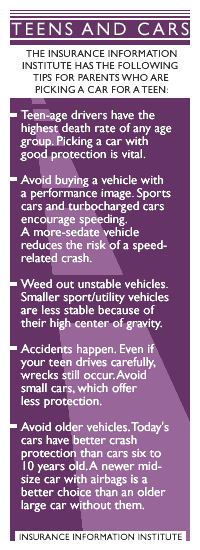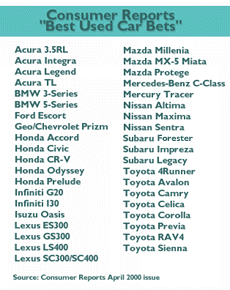|
Picking safe cars for teens
|
 |
June 20, 2000: 11:10 a.m. ET
Young drivers have the most risk of wrecks. Here's how to buy their cars
By Staff Writer Alex Frew McMillan
|
NEW YORK (CNNfn) - Hot rods and high jinx are as much of a part of teen-age life as homecoming and the prom. But for parents, buying a safe car might make all the difference.
Teens have the highest death rates from driving of any age group. In 1998, the most recent data available, 5,606 teen-agers died on the road, according to the Insurance Institute for Highway Safety.
That's down from the year before, when the figure was over 5,700. But it still means more than one in 10 people killed on the road was a teen. The United States has a worse problem than any other country, according to the group.
"The bottom line is, teen-agers are the most overinvolved, and the most frequently involved [in wrecks] -- they're more likely to die, and more likely to be crashing," said Julie Rochman, vice president of communications for the Arlington, Va.-based group. "They think they're invincible."
Not just recklessness leads to wrecks
Various reasons contribute to the number of young drivers involved in auto accidents. A lack of experience, a lust for speed, and distracting friends have all played a part in the high accident rate.
 Alcohol-related car crashes get a lot of attention. But teens are much less likely to have alcohol in their system than other drivers who crash. Teens also have a high proportion of single-vehicle collisions. Alcohol-related car crashes get a lot of attention. But teens are much less likely to have alcohol in their system than other drivers who crash. Teens also have a high proportion of single-vehicle collisions.
The risk of a crash per mile driven is four times higher between 16 and 19 as among older drivers, according to the IIHS. The riskiest years for driving are ages 16 and 17, even though teens drive less than all but the oldest drivers.
The stats are scary. But there are ways of trying to make sure the numbers work out in your and your offspring's favor.
Of course, the first step is to make sure your teen is in control behind the wheel. Rochman encourages parents to see that teens get plenty of daytime driving experience before they let them drive at night, for instance.
Rochman also said parents should lay down a "no teen passengers" rule for the first few months while the young driver learns to drive.
"When the parent gets out of the car, everything changes. Teen-agers try to distract each other. They play games within the vehicle and between vehicles," she said.
Time to hit the books
But in the end, there's only so much a parent can do about how the teen drives. Then it comes down to buying the right car or truck.
That's where parents might want to do some homework of their own.
"If you do some good research, you can come up with a car that fits just about everyone's needs and budgets," said Gabriel Shenhar, senior auto test engineer for Consumer Reports.
In its April 2000 issue, for instance, Consumer Reports broke out 40 vehicles it has tested as its "Best Bets" if you're in the market for a used car.
They include a broad range of popular models, including the Acura Integra, the Ford Escort, the Hondas Civic and Accord, several Lexuses and the Toyotas 4Runner, Camry and Celica.
Reliability is a consideration because it can become a safety issue, Shenhar said, particularly for teen-aged girls. "You don't want your kid stranded somewhere," he said.
Safety not always the first concern
Unfortunately, safety is not always a parent's first concern, car safety experts say. Other issues such as cost and insurance rates are normally primary.
 "If money is no object, you pick safe," said Jeanne Salvatore, vice president of consumer affairs with the Insurance Information Institute. "But it is for most families, so safety intersects in the middle." "If money is no object, you pick safe," said Jeanne Salvatore, vice president of consumer affairs with the Insurance Information Institute. "But it is for most families, so safety intersects in the middle."
Car-safety experts say that teens are often best off driving the family's big sedan. Newer is always better.
It's tempting to buy teens a cheap old hulker, figuring they're going to get in a fender bender or two. But this is the most dangerous route, car experts say.
Old cars have fewer safety features. They are also more likely to break down. They may also have developed structural problems such as rust.
On the other hand, most cars sold after 1994 in the United States have dual airbags. That was required for all passenger cars after 1997 and for all light trucks as of 1998, according to Rochman, though many manufacturers beat those deadlines.
Newer cars have better engineering. Though the perception is that newer cars are less solid than the metal tanks of days of yore, solidity can be overrated quality in a car. All things being equal, your teen is safer in a larger, heavier car. But that's not the only consideration.
"You want a vehicle that's going to crash and crumple in a controlled way, so you don't get a lot of sharp metal intruding into the car," Rochman said. "The force and the energy have to go somewhere. You actually want the car to look bad in the crash." Engineers are doing a better job now of building cars that can crumple and take the brunt of a crash, she said.
Crash tests for dummies
The federal government's National Highway Traffic Safety Administration tests cars for safety and publishes the results on its Web site. You can search by make or model, or by entire categories.
The NHTSA also has a brochure, "Buying a Safer Car," that is also available free on its Web site.
The IIHS also does its own crash tests. It also rates vehicles on its Web site. The Toyota Camry, Ford Taurus, Chevrolet Lumina, Volkswagen Beetle and Subaru Forester all crumple well, Rochman said.
The Insurance Information Institute also provides a tip sheet on picking a safe car for teens on its Web site.
"A safe car is extremely important, simply because the youthful driver is less experienced, and they're a little bit more immature," Salvatore said.
Of course all families are different, with different budget restrictions. The "newer is better" rule is good news for teens but not for the parents who have to foot the bill.
But dig around and you should find something that fits with your wallet and safety requirements, experts say.
In making the right choice for a car, there are some kinds of cars that teens definitely should not be driving. Small sport/utility vehicles have stability problems because of their high center of gravity, according to insurance experts. Teens are more at risk in those kinds of vehicles because they make more driving errors and tend to overcorrect to combat them.
Sports cars and turbocharged cars are also not a good idea, according to insurers. Teens "want to drive fast," Rochman explained. "If you give them a vehicle that begs them to drive faster, you're just making a bad situation worse."
The good news is that teen driving deaths are dropping. They are down 36 percent over a quarter-century, according to the IIHS.
Car manufacturers are also improving on the mechanics of safety, Rochman went on. "They're designing safety into the vehicles. Newer vehicles are safer from a structural point of view," she said. 
|
|
|
|
|
 |

|

